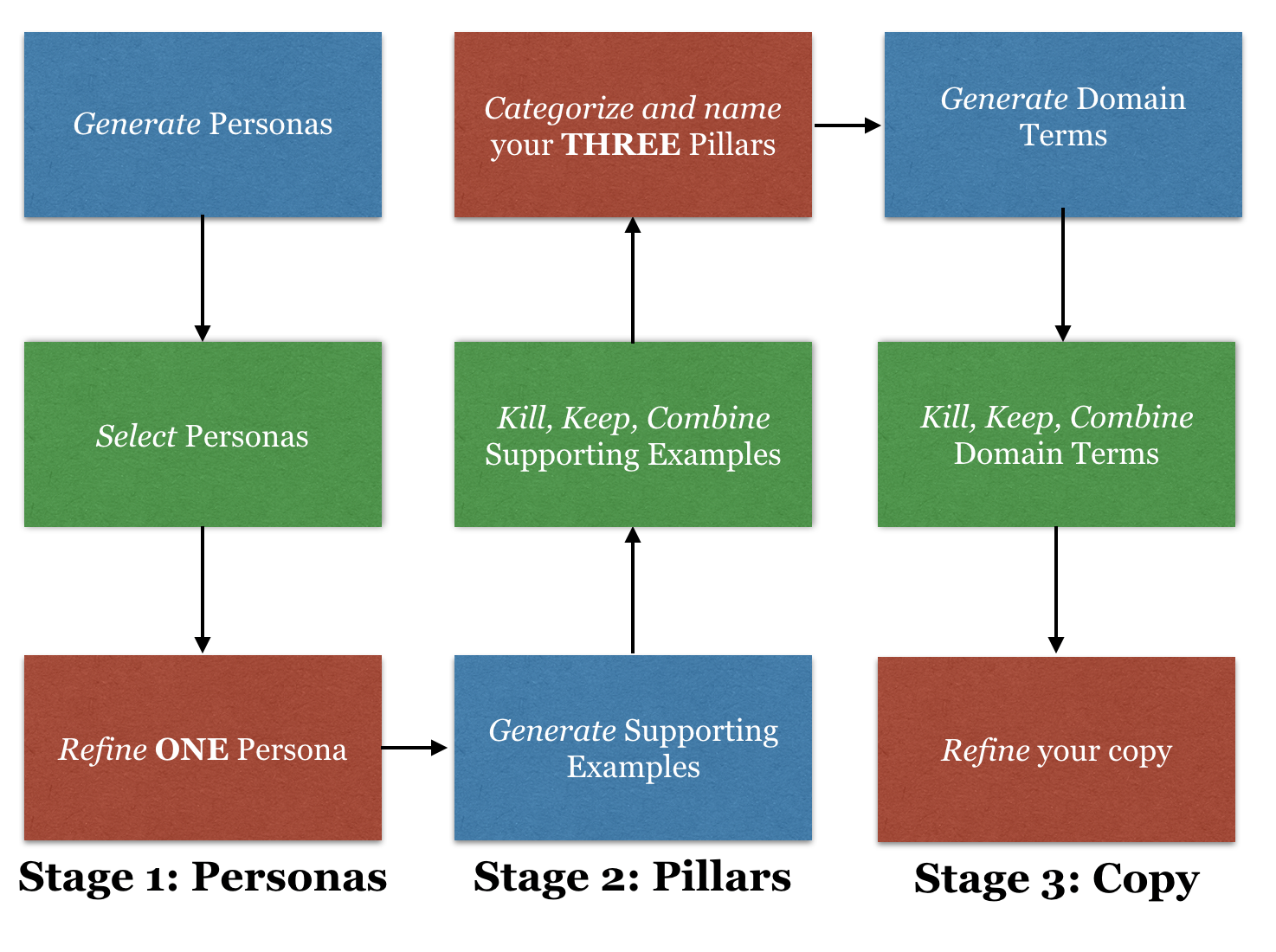Yes, we used this process to write that headline.
One of our favorite types of engagements at Reify is when a client brings us in to help them rewrite the copy on their homepage or some other prominent marketing collateral. Initially, its great because it allows us to dig deeply into the history and intent behind the company and the product. As things move along, our impressions of what the company is trying to sell and who they are trying to sell to is often instructive to founders and marketing executives — because there’s often a delta there. All in all, the process of discovery and definition is one that we find very satisfying.
After sending out the Nth proposal to a company for this kind of gig, where we help them translate their product and vision into some catchy phrases that sell well, I decided that it would be interesting to publicly document the basic procedure that we use to approach this kind of work. I even decided to make a spiffy graphic!
 Generate → Filter → Refine, repeat.
Generate → Filter → Refine, repeat.
Generate → Filter → Refine
For each of the stages in our process, we follow the same basic steps:
-
We generate a list
-
We filter that list, selecting what we need
-
We refine the results into the form we’re looking for
Let’s see how that plays out stage by stage.
Stage 1: Personas
The whole process starts where any good marketing process starts — with the people who are going to buy the product. For each project and company at hand, there may or may not be very well established definitions for their “ideal customer profile” or “buyer persona” or whatever you want to call it. The idea is a simple one: make sure your marketing copy reads well by putting yourself in the mindset of the target audience.
We start out by coming up with a list of potential personas that our messaging might want to target. For a marketing site for a software company, we’ll recommend that we start with one really solid persona. Starting with more than one is a recipe for trouble, and even if you’re going to insist on going with two in the long run, you’ll need to do them one by one. So, just start with one — trust us.
Once you’ve settled on your target audience, it’s time to flesh them out in your mind. We point clients to this Geckoboard post about personas and we often use their questions. Asking yourselves uncomfortable, weird questions about potential customers, for whatever reason, always helps me. Something about stepping outside of my comfort zone snaps me into the mindset I need to be able to consider things from the right perspective. Your mileage may vary.
Stage 2: Pillars
Once we’ve got our persona at hand, we can use that as an input into the next stage: our messaging pillars. These three pillars are at the heart of this Pardot blog post here about brand messaging that taught us a lot about how to systematically approach something that everyone struggles with from time to time: writing good, coherent copy.
In short, the pillars are the three unique things that drive customers to buy and use our products. We’ve found that trying to get to these pillars in a “bottom up” way works very well. We start with the people who will be buying, then list the things they care about (what we call “supporting examples”), and then sort and filter those until they form cogent groups.
Taking a look at the example framework that Pardot provides, you can see how the examples support the headline benefits, which support the pillars. These pillars are represented in the elevator pitch, use a specific tone, and have a specific target audience in mind. The brand promise, positioning statement, and mission should all align with these pillars as well.
](/images/1*elW2Qhu580C9NucR4b9Ctw.png) Source: https://www.pardot.com/blog/how-to-create-brand-messaging-that-really-resonates/
Source: https://www.pardot.com/blog/how-to-create-brand-messaging-that-really-resonates/
The value of filling out this type of framework for your product goes way beyond using it for the copy on your homepage. It’s a useful, reusable tool that you can apply to any corporate communications. Emails, reports or proposals, invoices, everything.
Stage 3: Copy
Now that we’ve got our persona and our messaging framework under our belts, we’re really ready to roll. We can again generate a list, filter it, and then refine the results.
There are lots of different approaches for generating and recording the terms that will making up the prominent aspects of your newly scribed marketing copy. You can use mindmaps, just make big lists, use sticky notes, write things in google documents, or any combination of the above. Take the time to write down the phrases that you notice customers repeating. The terms you use internally. The terms you’ve thought about but haven’t been quite able to polish yet. Anything is in play.
Because we’ve started with our audience, and then refined our notions of them, and tried to keep ourselves as honest as possible in evaluating things from their perspective, we can have a lot of confidence that we’ll be able to speak to them directly with our messaging.
Even if we do occasionally miss the mark, our approach still has a leg up on what we mostly used to do, also known as “winging it.” Now that we’ve selected an audience, we have a group of people to test our theories with. In a sense, we can use the evaluations of our new copy as feedback right back into the process diagrammed above. As we learn more about our customers, as the landscape and product changes, we’ll want to be able to make tweaks, and having a framework makes that considerably simpler.
What do you think? How do you write copy that you know your audience will love? We’d love to hear from you!
